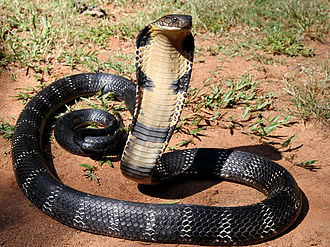The king cobra (Ophiophagus hannah) is a species of venomous elapid snake endemic to jungles in Southern and Southeast Asia. The sole member of the genus Ophiophagus, it is distinguishable from other cobras, most noticeably by its size and neck patterns. The king cobra is the world's longest venomous snake, with an average length of 3.18 to 4 m (10.4 to 13.1 ft), reaching a maximum of 5.85 m (19.2 ft).
The king cobra is also referred to by the common name "hamadryad", especially in older literature. Hamadryas hannah was the scientific name used by Danish naturalist Theodore Edward Cantor in 1836 who described four king cobra specimens, three captured in the Sundarbans and one in the vicinity of Kolkata. Naja bungarus was proposed by Hermann Schlegel in 1837 who described a king cobra zoological specimen from Java. In 1838, Cantor proposed the name Hamadryas ophiophagus for the king cobra and explained that it has dental features intermediate between the genera Naja and Bungarus. Naia vittata proposed by Walter Elliot in 1840 was a king cobra caught offshore near Chennai that was floating in a basket. Hamadryas elaps proposed by Albert Günther in 1858 were king cobra specimens from the Philippines and Borneo. Günther considered both N. bungarus and N. vittata a variety of H. elaps. The genus Ophiophagus was proposed by Günther in 1864. The name is derived from its propensity to eat snakes.
The king cobra has a wide distribution in South and Southeast Asia. It occurs up to an elevation of 2,000 m (6,600 ft) from the Terai in India and southern Nepal to the Brahmaputra River basin in Bhutan and northeast India, Bangladesh and to Myanmar, southern China, Cambodia, Thailand, Laos, Vietnam, Malaysia, Singapore, Indonesia and the Philippines.
In northern India, it has been recorded in Garhwal and Kumaon, and in the Shivalik and terai regions of Uttarakhand and Uttar Pradesh. In northeast India, the king cobra has been recorded in northern West Bengal, Sikkim, Assam, Meghalaya, Arunachal Pradesh, Nagaland, Manipur and Mizoram. In the Eastern Ghats, it occurs from Tamil Nadu and Andhra Pradesh to coastal Odisha, and also in Bihar and southern West Bengal, especially the Sundarbans. In the Western Ghats, it was recorded in Kerala, Karnataka and Maharashtra, and also in Gujarat. It also occurs on Baratang Island in the Great Andaman chain.
The king cobra's skin is olive green with black and white bands on the trunk that converge to the head. The head is covered by 15 drab coloured and black edged shields. The muzzle is rounded, and the tongue black. It has two fangs and 3–5 maxillar teeth in the upper jaw, and two rows of teeth in the lower jaw. The nostrils are between two shields. The large eyes have a golden iris and round pupils. Its hood is oval shaped and covered with olive green smooth scales and two black spots between the two lowest scales. Its cylindrical tail is yellowish green above and marked with black. It has a pair of large occipital scales on top of the head, 17 to 19 rows of smooth oblique scales on the neck, and 15 rows on the body. Juveniles are black with chevron shaped white, yellow or buff bars that point towards the head. Adult king cobras are 3.18 to 4 m (10.4 to 13.1 ft) long. The longest known individual measured 5.85 m (19.2 ft). Ventral scales are uniformly oval shaped. Dorsal scales are placed in an oblique arrangement.
The king cobra is sexually dimorphic, with males being larger and paler in particular during the breeding season. Males captured in Kerala measured up to 3.75 m (12.3 ft) and weighed up to 10 kg (22 lb). Females captured had a maximum length of 2.75 m (9 ft 0 in) and a weight of 5 kg (11 lb). The largest known king cobra was 5.59 m (18 ft 4 in) long and captured in Thailand. It differs from other cobra species by size and hood. It is larger, has a narrower and longer stripe on the neck.
The king cobra is an apex predator and dominant over all other snakes except large pythons. Its diet consists primarily of other snakes and lizards, including Indian cobra, banded krait, rat snake, pythons, green whip snake, keelback, banded wolf snake and Blyth's reticulated snake. It also hunts Malabar pit viper and hump-nosed pit viper by following their odour trails. In Singapore, one was observed swallowing a clouded monitor. When food is scarce, it also feeds on other small vertebrates, such as birds, and lizards. In some cases, the cobra constricts its prey using its muscular body, though this is uncommon. After a large meal, it lives for many months without another one because of its slow metabolic rate.
